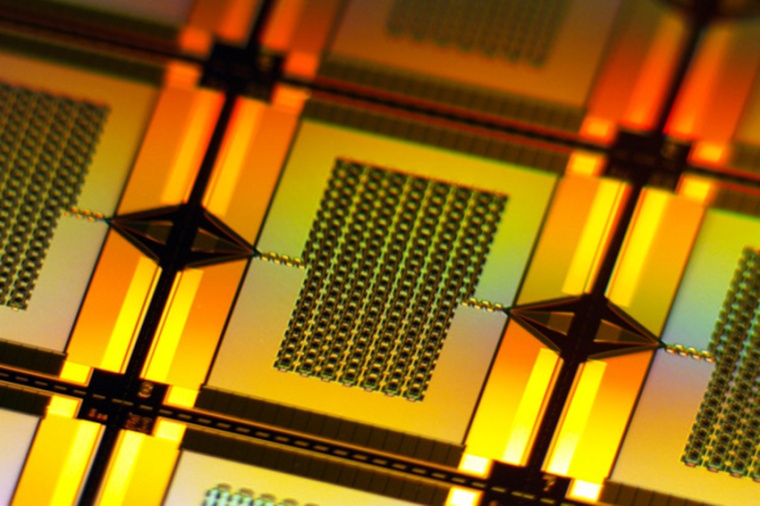Boosting quantum signals
Squeezing noise over a broad frequency bandwidth in a quantum system could lead to faster quantum measurements.
A certain amount of noise is inherent in any quantum system. For instance, when researchers want to read information from a quantum computer, which harnesses quantum mechanical phenomena to solve certain problems too complex for classical computers, the same quantum mechanics also imparts a minimum level of unavoidable error that limits the accuracy of the measurements. Scientists can effectively get around this limitation by using parametric amplification to squeeze the noise While the total amount of noise remains the same, it is effectively redistributed. Researchers can then make more accurate measurements by looking only at the lower-noise variable.

A team of researchers from MIT and elsewhere has now developed a new superconducting parametric amplifier that operates with the gain of previous narrowband squeezers while achieving quantum squeezing over much larger bandwidths. Their work is the first to demonstrate squeezing over a broad frequency bandwidth of up to 1.75 gigahertz while maintaining a high degree of squeezing. In comparison, previous microwave parametric amplifiers generally achieved bandwidths of only 100 megahertz or less. This new broadband device may enable scientists to read out quantum information much more efficiently, leading to faster and more accurate quantum systems. By reducing the error in measurements, this architecture could be utilized in multiqubit systems or other metrological applications that demand extreme precision.
“As the field of quantum computing grows, and the number of qubits in these systems increases to thousands or more, we will need broadband amplification. With our architecture, with just one amplifier you could theoretically read out thousands of qubits at the same time,” says electrical engineering and computer science graduate student Jack Qiu, who is a member of the Engineering Quantum Systems Group together with William D. Oliver and Kevin P. O’Brien. Superconducting quantum circuits process and transfer information in quantum systems. This information is carried by microwave electromagnetic signals comprising photons. But these signals can be extremely weak, so researchers use amplifiers to boost the signal level such that clean measurements can be made.
However, the Heisenberg Uncertainty Principle requires a minimum amount of noise be added during the amplification process, leading to the standard quantum limit of background noise. However, a Josephson parametric amplifier can reduce the added noise by squeezing it below the fundamental limit by effectively redistributing it elsewhere. Quantum information is represented in the conjugate variables. However, in many instances, researchers need only measure one of these variables – the amplitude or the phase – to determine the quantum state of the system. In these instances, they can squeeze the noise, lowering it for one variable, say amplitude, while raising it for the other, in this case phase. The total amount of noise stays the same due to Heisenberg’s Uncertainty Principle, but its distribution can be shaped in such a way that less noisy measurements are possible on one of the variables.
A conventional Josephson parametric amplifier is resonator-based: It’s like an echo chamber with a superconducting nonlinear Josephson junction in the middle. Photons enter the echo chamber and bounce around to interact with the same Josephson junction multiple times. In this environment, the system nonlinearity is enhanced and leads to parametric amplification and squeezing. But, since the photons traverse the same Josephson junction many times before exiting, the junction is stressed. As a result, both the bandwidth and the maximum signal the resonator-based amplifier can accommodate is limited. The researchers took a different approach. Instead of embedding a single or a few Josephson junctions inside a resonator, they chained more than 3,000 junctions together, creating a Josephson traveling-wave parametric amplifier. Photons interact with each other as they travel from junction to junction, resulting in noise squeezing without stressing any single junction.
Their traveling-wave system can tolerate much higher-power signals than resonator-based Josephson amplifiers without the bandwidth constraint of the resonator, leading to broadband amplification and high levels of squeezing, Qiu says. “You can think of this system as a really long optical fiber, another type of distributed nonlinear parametric amplifier. And, we can push to 10,000 junctions or more. This is an extensible system, as opposed to the resonant architecture,” he says.
A pair of pump photons enters the device, serving as the energy source. Researchers can tune the frequency of photons coming from each pump to generate squeezing at the desired signal frequency. For instance, if they want to squeeze a 6-gigahertz signal, they would adjust the pumps to send photons at 5 and 7 gigahertz, respectively. When the pump photons interact inside the device, they combine to produce an amplified signal with a frequency right in the middle of the two pumps. This is a special process of nonlinear wave mixing. “Squeezing of the noise results from a two-photon quantum interference effect that arises during the parametric process,” he explains.
This architecture enabled them to reduce the noise power by a factor 10 below the fundamental quantum limit while operating with 3.5 gigahertz of amplification bandwidth – a frequency range that is almost two orders of magnitude higher than previous devices. Their device also demonstrates broadband generation of entangled photon pairs, which could enable researchers to read out quantum information more efficiently with a much higher signal-to-noise ratio, Qiu says.
While Qiu and his collaborators are excited by these results, he says there is still room for improvement. The materials they used to fabricate the amplifier introduce some microwave loss, which can reduce performance. Moving forward, they are exploring different fabrication methods that could improve the insertion loss. “This work is not meant to be a standalone project. It has tremendous potential if you apply it to other quantum systems – to interface with a qubit system to enhance the readout, or to entangle qubits, or extend the device operating frequency range to be utilized in dark matter detection and improve its detection efficiency. This is essentially like a blueprint for future work,” he says. (Source: MIT)
Link: Engineering Quantum Systems Group, Massachusetts Institute of Technology, Cambridge, USA











